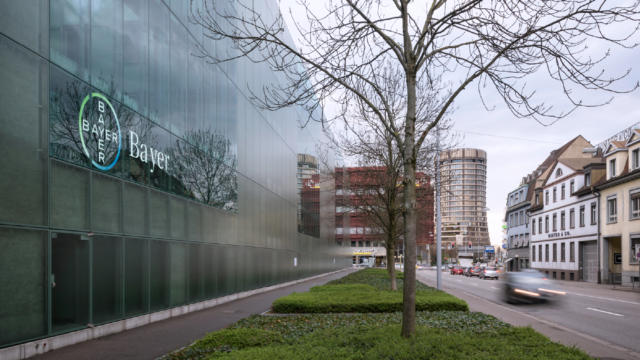
阅读新的Forrester报告:Anaplan的总体经济影响™
第三方研究发现,在3年的时间内,多个客户组合的投资回报率为303%
现在我们改变了anplan中的数字,并在不到一分钟的时间内看到对我们业务的财务影响。Philipp Ahrendt,金融建模和分析主管
场景建模过去需要花费数小时,现在可以进行更多的探索和更好的决策
减少了准备预测和相关报告材料的时间,从而有更多的时间进行分析和洞察
The discussions are now being facilitated using Anaplan, and during the meetings, the head of controlling uses Anaplan dashboards to guide the attendees through the financials and potential scenarios. This is a huge step forward for Bayer’s digital agenda. The switch from printed, autographed books to digital solutions based on Anaplan technology symbolizes Bayer’s transformed planning and decision-making process and demonstrates how Corporate Controlling has evolved to positively influence the company’s digitization strategy.
\r\nBayer, a $51 billion company headquartered in Germany, has a history of innovation dating back to its founding in 1863. Its three divisions—Crop Science, Pharmaceuticals, and Consumer Health—each do their financial planning in a group-wide harmonized SAP planning system. “Our divisions plan at different levels of granularity due to the nature of their businesses,” Ahrendt explains. “However, as the Corporate Controlling team supports all financial planning processes that include all Bayer divisions and functions, the divisional plans need to be consolidated and harmonized to create a consistent picture.”
\r\nThose processes include the annual Operational Planning Conference (OPC), at which Bayer plans for the coming year and sets its three-year financial outlook; an annual Strategic Conference (StraCo) that generates a 10-year plan and analyzes investments, divestments, mergers, acquisitions, and other strategic options; and Quarterly Business Reviews (QBRs). For each of these processes, the Controlling staff used to perform extensive manual preparation, much of it in spreadsheets and presentation tools. “We needed a more agile, efficient and sustainable solution,” Ahrendt says.
\r\nThe Controlling team first sought a solution for long-term financial planning (the StraCo) but soon realized that one system, intelligently designed and deployed, could support all corporate-level financial planning events. There were numerous requirements for the new tool. As the data would be loaded from the group-wide planning and reporting system with different levels of granularity, the new tool needed to be flexible in structure and connectable to SAP databases. To be able to cope with changing demands, the tool should not need dedicated support from outside the Controlling team; being self-sufficient would significantly increase agility. Furthermore, numbers and their connection to underlying assumptions should be transparent, so that instead of simply consolidating divisional plans, simulating group business cases through scenarios and sensitivities would be enabled.
\r\n“We needed to build a fully integrated financial model, where everything is connected,” Ahrendt states. “One where we can enter a 1% volume increase and immediately see the impact on the sales, cost of goods sold, cash flow, and net debt.”
\r\nNear the end of 2019, Ahrendt and the project team worked with Anaplan to build a proof of concept. After it was shared, the rest of the Controlling team was immediately sold. The team was able to quickly jump on the Anaplan modeling approach and created the first usable models within one week.
\r\nAs of today, Bayer’s Corporate Controlling team runs several financial models in Anaplan. These models share the same calculation logic but have different time horizons; they support all planning processes from quarterly forecasts in the QBR to 10-year outlooks in the StraCo. For each process, a dedicated app has been built on top of the models to enable discussions and decision-making in the meetings.
\r\nThe apps share common navigation principles and relevant group-level KPIs such as net sales, EBITDA, free cash flow, earnings per share, and net debt. “The full financial picture is always available in Anaplan in an appealing interface,” Ahrendt notes.
\r\nScenarios and sensitivities—“where the magic happens,” as Ahrendt says—are key elements of Bayer’s financial models. Users can simulate entire business cases by activating and deactivating scenarios or adjusting sensitivities. Thanks to the digital solution, the financial effect of the altered assumptions immediately becomes visible in all KPIs.
\r\nAnaplan’s simulation power is especially useful in the StraCo meeting, where the Board of Management discusses potential mergers, acquisitions, investments, and divestments. “In the past, people presented fully calculated proposals in the StraCo meeting,” Ahrendt recalls. “If somebody asked about a different deal structure or price, the presenter had to recalculate the effects, and was only be able to give an answer after the meeting. Now we change the numbers in Anaplan and see the financial impact on our business in less than a minute.”
\r\nFor Corporate Controlling, the most obvious benefit of the new solution is faster preparation of materials for planning processes. “Tasks that used to take five to six days, back when the output was still a physical book, can now be completed in about three days,” Ahrendt mentions. By eliminating manual efforts in data collection and aggregation, the team gains time for qualitative analysis and to prepare the storyline for the presentations.
\r\nBeyond efficiency, the team’s interactive models are a far superior product that encourages exploration and discussion. This advantage has been noticed at the highest levels of Bayer’s leadership. “It’s a huge step to give a digital presentation via Anaplan to all the board members,” Ahrendt says. “We received the feedback from our CFO that they have better discussions, and they make better decisions, because people immediately know the financial impact of their choices.” These faster, more confident responses to changing business conditions are a direct result of the trust generated by the transparency of the numbers and the underlying assumptions.
\r\nThe new solution has also increased confidence in the Corporate Controlling team itself. “Everybody was able to quickly get a handle on Anaplan and experience success,” Ahrendt concludes. “We felt empowered, and seeing the creativity of our colleagues was quite amazing. We are a small team, but with our financial models in Anaplan, we have a big impact.”
\r\n"}}" id="text-1b99d4436f" class="cmp-text">不久前,在全球生命科学公司拜耳,公司控制团队为季度和年度规划会议做准备是一个多步骤的过程:他们将从部门、职能和公司计划系统中收集信息,并计算进一步的kpi,使数据合理化,以一致的可视化格式呈现,并为参加规划会议的管理委员会和高级管理人员制作“预读”书。拜耳公司控制部门金融建模与分析部门负责人Philipp Ahrendt回忆道:“这本书是由控制部门负责人用笔签名的。”“整个过程需要5到6天,如果在这段时间里有什么变化,我们就必须重新开始。但现在情况不同了。我们在2020年年中首次在系统中实时展示了财务状况,截至2021年,所有规划会议都以这种方式进行。”
讨论现在正在使用anplan进行,在会议期间,控制负责人使用anplan仪表板来指导与会者了解财务和潜在的场景。这是拜耳数字化议程向前迈出的一大步。从印刷签名书籍到基于Anaplan技术的数字解决方案的转变象征着拜耳计划和决策过程的转变,并展示了企业控制如亚搏彩票app官方网站何演变为积极影响公司的数字化战略。
拜耳公司总部位于德国,市值510亿美元,其创新历史可以追溯到1863年成立之初。它的三个部门——作物科学、制药和消费者健康——每个部门都在集团范围内统一的SAP计划系统中进行财务规划。Ahrendt解释道:“由于业务性质不同,我们的部门计划的粒度不同。“然而,由于公司控制团队支持包括拜耳所有部门和职能在内的所有财务规划流程,因此需要对各部门的计划进行整合和协调,以形成一致的图景。”
这些过程包括年度业务规划会议(OPC),拜耳在该会议上计划来年并设定其三年财务展望;一年一度的战略会议(StraCo)负责制定10年计划,并分析投资、剥离、合并、收购和其他战略选择;而且季度业务回顾(QBRs)。对于这些过程中的每一个,控制人员过去都要进行大量的手工准备,其中大部分是在电子表格和演示工具中进行的。“我们需要一个更加灵活、高效和可持续的解决方案,”Ahrendt说。
控制团队首先寻求一个长期财务规划的解决方案(StraCo),但很快意识到一个系统,智能设计和部署,可以支持所有公司级别的财务规划事件。新工具有很多需求。由于数据将以不同的粒度级别从集团范围的规划和报告系统中加载,因此新工具需要具有灵活的结构并可连接到SAP数据库。为了能够应对不断变化的需求,该工具不应该需要来自控制团队之外的专门支持;自给自足将显著提高敏捷性。此外,数字及其与基础假设的联系应该是透明的,这样就可以通过场景和敏感性模拟集团业务案例,而不是简单地整合部门计划。
“我们需要建立一个完全整合的金融模式,在这个模式中,一切都是相互关联的,”Ahrendt说。“我们可以进入1%的销量增长,立即看到对销售、销售成本、现金流和净债务的影响。”
2019年底,Ahrendt和项目团队与Anaplan合作,建立了一个概念验证。在分享之后,控制团队的其他成员立即被出售。该团队能够快速地采用anplan建模方法,并在一周内创建第一个可用的模型。
截至目前,拜耳的公司控制团队在Anaplan运行多个财务模型。这些模型具有相同的计算逻辑,但具有不同的时间范围;它们支持从QBR的季度预测到StraCo的10年展望的所有规划过程。对于每个流程,都在模型的基础上构建了一个专用的应用程序,以便在会议中进行讨论和决策。
这些应用程序具有共同的导航原则和相关的集团级kpi,如净销售额、EBITDA、自由现金流、每股收益和净债务。阿伦特指出:“在Anaplan网站上,你总能以一种吸引人的界面看到完整的财务状况。
情景和敏感性——正如Ahrendt所说的“奇迹发生的地方”——是拜耳财务模型的关键要素。用户可以通过激活和取消场景或调整敏感性来模拟整个业务用例。得益于数字化解决方案,改变假设的财务影响立即在所有kpi中可见。
anplan的模拟能力在StraCo会议上特别有用,董事会在会议上讨论潜在的合并、收购、投资和撤资。“在过去,人们在StraCo会议上提出了经过充分计算的建议,”Ahrendt回忆道。“如果有人问一个不同的交易结构或价格,演讲者必须重新计算影响,只有在会议结束后才能给出答案。现在,我们改变了阿纳plan的数字,不到一分钟就能看到对我们业务的财务影响。”
对于公司控制来说,新的解决方案最明显的好处是更快地为计划过程准备材料。Ahrendt提到:“过去需要5到6天完成的任务,在输出还是一本实体书的时候,现在可以在3天左右完成。”通过消除数据收集和聚合中的手工工作,团队获得了定性分析的时间,并为演示文稿准备故事情节。
除了效率之外,团队的交互模型是一个非常优秀的产品,它鼓励探索和讨论。拜耳的最高领导层已经注意到了这一优势。阿伦特说:“通过Anaplan向所有董事会成员进行数字演示是一大步。”“我们从首席财务官那里得到的反馈是,他们进行了更好的讨论,做出了更好的决定,因为人们立即知道他们的选择对财务的影响。”这些对不断变化的商业环境做出的更快、更自信的反应,是由数字的透明度和基本假设所产生的信任的直接结果。
新的解决方案也增加了对公司控制团队本身的信心。Ahrendt总结道:“每个人都能够快速掌握ananplan并体验成功。“我们感觉被赋予了权力,看到同事们的创造力非常令人惊叹。我们是一个小团队,但凭借我们在Anaplan的财务模式,我们有很大的影响力。”

